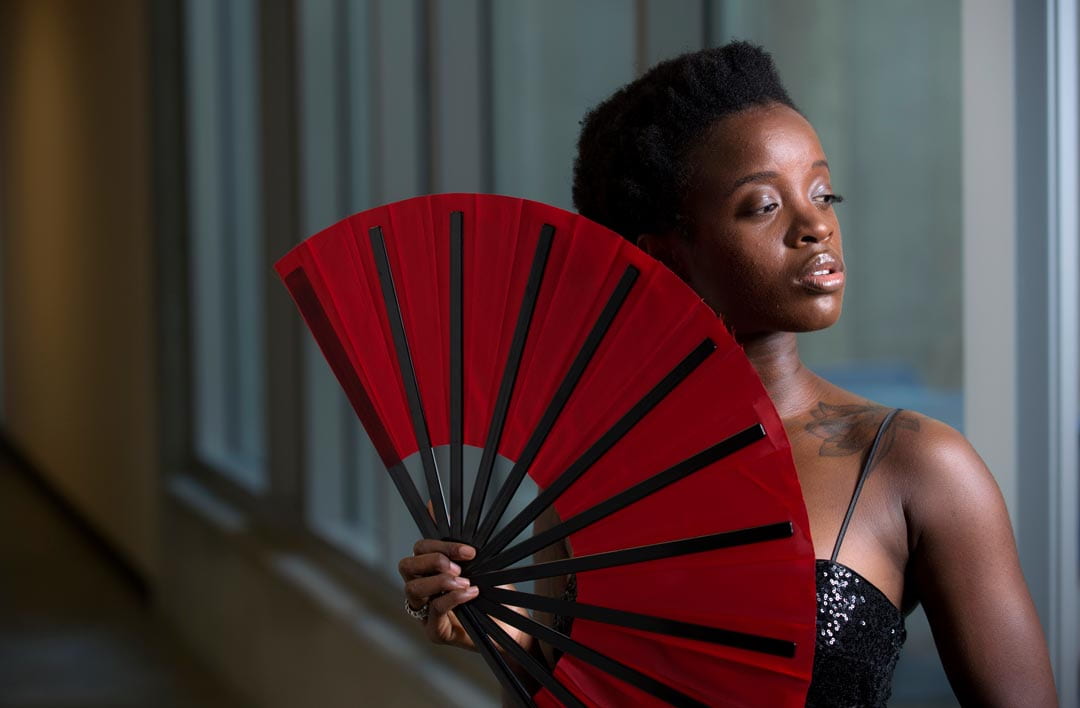A woman of many worlds
Multicultural, first-gen doctoral student strives to reconcile academia and the creative arts

Samantha Carter spent her younger years traversing the globe. The first-year visual studies Ph.D. student was born in Missouri, was raised in California, spent time in Vermont and her mother’s native Curaçao, earned degrees in Rhode Island and Amsterdam, and lived in Cuba before settling in Irvine. As she wrote in her UCI application essay, “Curaçao birthed me. California raised me. I found my heart in Cuba.”
One thing binds all of these places together for her: performance art. As a dancer, comic, writer and producer, Carter approaches life as a self-proclaimed “wild artist” straddling the line between academic and creative worlds. At UCI, she hopes to study the way marginalized artists navigate these worlds through digital tools, entering mainstream industries or designing niches of their own. And for Carter, a first-generation student whose coming-of-age was filled with the instability of several homes and insecurity over pursuing higher education, this research is personal.
As an undergraduate at Brown University, studying modern culture and media, she loved her program but often felt disoriented and had trouble adapting.
“It was definitely hard coming from a lower-class, poverty background to an institution where I was expected to know all the different types of silverware on the table and where most of my peers grew up more affluent than me,” Carter says. “I struggled with feelings of inadequacy, which I think a lot of undergraduates feel, but it’s amplified when you feel alone and unsure that you belong and aren’t really sure at first where to look for support.”
Self-doubt persisted through her master’s program at the University of Amsterdam, but encouragement from mentors and professors led her to continue in academia, even at universities where she felt out of her depth.
UCI, though, was different. The visual studies program, according to Carter, is “challenging, yet refreshingly down-to-earth.” The friendliness of the faculty, the availability of resources for first-gen students and the support of her peers were the biggest factors for Carter in choosing UCI – indeed, it was the only school she applied to.
The summer before starting here, she participated in the Competitive Edge program, an eight-week initiative designed to help incoming Ph.D. students underrepresented in their fields acclimate to the campus, access resources, and conduct research with faculty and peer mentors. Carter wrote a pitch for a television show starring marginalized actors and directors and intended through this “mutually beneficial, participatory” project to study how such artists use digital tools to break into Hollywood.
“I got to practice articulating my research, so I feel confident bringing it up now,” she says. “Working with my mentors helped assuage some of my insecurities and made me realize that I am smart enough to be here, I am deserving and capable of being in academia.”
Although first-year Ph.D. students focus mainly on taking classes, Carter has already begun conceptualizing her dissertation project: She plans to orchestrate her own production, recruiting marginalized artists from across Southern California, and will carry out an ethnographic study on how the cast and crew adapt to the creative workplace. This, she hopes, will be the first of many ventures in a long academic career spent both studying her field and actively participating in it as a creative producer.
“I love to write, read, present, create and be in the throes of knowledge production,” Carter says. “I’m always finding ways to straddle the line between creative and academic – because I’m definitely both.”
She remembers a formative phone call with film & media studies professor Fatimah Tobing Rony just before beginning her first quarter at UCI. When discussing Carter’s plan of study, Rony asked her to evaluate the “landscape of her life” and make sure her academic goals aligned with her “wild artist” identity, her family history and her passions. Reflecting on the myriad worlds she’d already experienced, Carter opted to pursue a career as an “artist-academic” and is determined to make the creative world – and higher education – more accessible to students like herself.
“Just the fact that I’m still here in academia, despite all the things that could have taken me out or in a whole different direction, makes me so proud,” she says. “Coming into visual studies at UCI feels like walking into a space filled with a lot of different people who are going to help form me into the academic I’d like to be.”